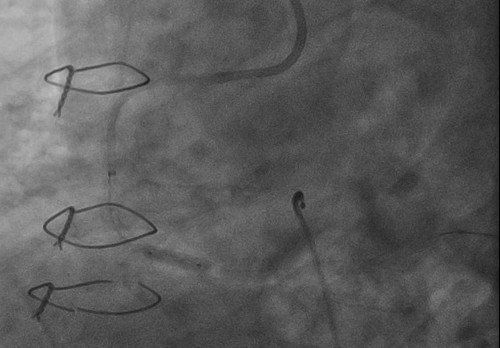Case 8: Aneurysmal RCA Disease
Case Presentation
- A 74-year-old male presented with left sided chest pain at rest and dyspnea on exertion.
- Medical history: HTN, HLD, CAD s/p multiple PCIs and CABG 1999.
- Medications: ASA 81mg, Losartan 50mg, Metoprolol XL 100mg, Isosorbide Mononitrate 30m, Atorvastatin 40mg
- Coronary angiogram revealed 3V CAD : mid LAD-CTO, Ramus 80-90%, and aneurysmal RCA with 90% stenosis (just distal to aneurysmal segment) and patent LIMA to LAD.
- Planned for aneurysmal RCA intervention.
Angiogram
Angiogram
PCI Strategy
- Given the presence of aneurysm prior to the lesion, we anticipated the difficult wiring through the aneurysmal segment of RCA.
- AL 0.75 6F guide catheter
- To negotiate through an aneurysm, planned to use a wire with hydrophobic coated and a stiffer tip (better tactile feedback and excellent torqueability), along with a microcatheter for additional support.
- Our wire choice – Fielder and FineCross > Gaia > MiracleBros and would consider angulated microcatheter as needed.
- With AL 0.75 6F guide catheter, Fielder and FineCross microcatheter was used to navigate the lesion but it was unsuccessful to exit the aneurysmal segment.
- Then, we exchanged to Gaia second (Asahi), followed by Gaia third (Asahi) to negotiate the artery without success.
- Finally, we opted to use an angulated microcatheter (Supercross 90) and Fielder, then able to navigate through the aneurysmal segment.
- A Guidezilla 6F was advanced for a better support.
- Predilatation was done by using non-compliant balloon 3.5/12mm.
- With the support of 6F AL 0.75 and Guidezilla, one DES (4/16mm) was implanted in dRCA without any difficulty.
Final Angiogram
Learning Points
- Use of microcatheter is important as much as guidewire selection in a challenging case.
- The presence of wire’s flexibility and excellent trackability is essential to tackle these challenging anatomy.
- The challenging part to wire an aneurysm is that the wire tends to coil up inside the aneurysm and often requires a stiffer wire with hydrophobic coated tip (i.e. MiracleBros, Gaia) to negotiate through the exit of the aneurysmal segment.
- Angulated microcatheter (i.e. Supercross, Venture) provides a better support and facilitates in wiring through a severely angulated side branch and aneurysmal lesion.













